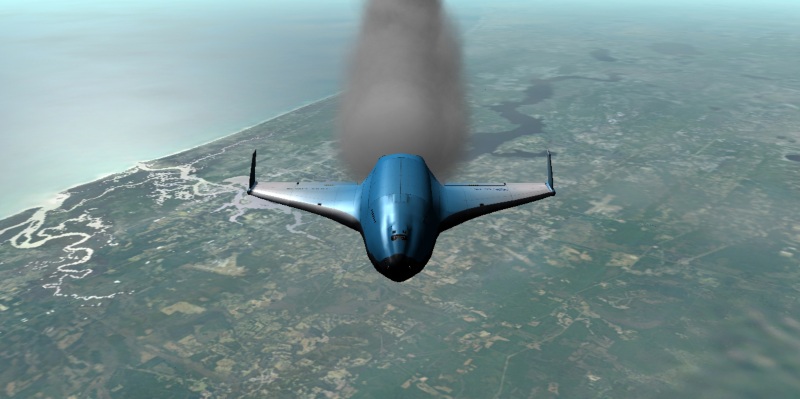OrbiterWiki:Random add-on
Random add-ons displayed on the Main Page are selected from the following list. Every addon in the list has an equal chance of appearing on the Main Page. Feel free to add more - just edit this list!
Note that you must be a registered user to edit this list.
List
These are all the add-ons which have a precis and can appear on the Main Page. The add-ons are listed alphabetically.
| See main article CVEL. | |
|
CVE-lite (abridged Common Vessel Extensions) is a programming library to aid developers of add-on vessels for Orbiter 2003-2006. It extends the native Orbiter VESSEL class with additional functionality for multiple payloads, enhanced mesh handling or scenario-file based multistage support. It implements the Generic Payload Description System (GPDS) scenario syntax to allow the end user to express via simple lines in the scenario file any payload and, if using another CVEL vessel, any additional upper stages. (More...)
| |
|
The DeltaGliderIII was a vessel addon designed for Orbiter by Dansteph. It featured highly realistic and fully functional cockpit instruments, included flight instruments along with controls for the life support system, electrical systems, and fuel systems. The DeltaGliderIII simulated a live crew which could be killed by incorrect cabin pressure, temperature or CO2 level. Unlike most vessels in Orbiter at the time, the DeltaGliderIII was able to simulate damage due to overloads such as extreme G-forces or reentry temperature, damaging or destroying the vessel. Crew onboard a DeltaGliderIII were able to perform Extra-Vehicular Activities, also a first for Orbiter vessels at the time. (More...)
| |
|
OMB was a MFD designed for Orbiter which was capable of a rudimentary simulation of human physiological reactions to external agents common in space travel. It featured a highly realistic and a fully functional input selection, which includes not only a sophisticated human tolerance estimator but also controls the level of effect of each different hazard. OMB assumed a live crew of one who can die if pressures of solitary flight become unacceptable and cause a directional error. Unlike most addons in Orbiter at the time, OMB concentrated on failures in response to human choices limiting a vessel's ability to function. Released in 2003, OMB was one of the very first realism-enhancement addons for Orbiter. (More...)
| |
|
Project Apollo for Orbiter (aka NASSP) simulates the Apollo missions to Earth orbit and the Moon, and is slowly expanding to simulate planned post-Apollo missions that never flew. The latest beta version features a near-full implementation of the control panels in the Command Module and Lunar Module, and an increasingly accurate simulation of the internal systems (e.g. electrical distribution, fuel cells). Also in the latest beta is support for the Virtual AGC software, which allows you to run precisely the same on-board guidance software as used by the real Apollo Guidance Computer. (More...)
| |
|
Space Shuttle Deluxe was an Orbiter addon based on the code and model of the stock Atlantis which came with Orbiter 2006. The goal of the project was to fill in the virtual cockpit with active controls, and to make as detailed and accurate a flight model as possible... (More...)
| |
|
WindowTack saves and restores the positions of various Orbiter windows. Every time you move a window, WindowTack saves its position. Next time you open it, WindowTack will move the window to its last saved position. (More...)
| |
The XR-5 Vanguard is a high-performance Spacecraft created for Orbiter by the Altea Aerospace team. The XR5's mesh was designed by Russel Hicks, texturing work done by PennyBlack, and payloads designed by Carmen A & Tom Fisher. Coding work to add multiple subsystems, failure modes and Payload Management are done by Douglas Beachy, as with other vessels in the XR series. The initial 1.0c release came on April 20, 2008, and the most recent release was 1.13 on February 20, 2018.
Design ConceptThe XR5 was designed as a single stage to orbit, reusable spaceplane able to carry up to 18 passengers and up to 432 metric tonnes of cargo to low Earth orbit. The exact design parameters for the XR5 are variable, depending on the preferences set by a user in the configuration file, but with realism settings set to their highest levels, the XR5 proves a difficult vessel to fly successfully. Like the rest of the XR fleet, scramjet engines are typically used during the bulk of the ascent to orbit, providing orbital velocity in the high atmosphere before conventional rocket engines are used to provide the final orbital insertion above the altitude where the scramjet engines are effective. FeaturesCurrent features of the XR5 include:
PrecisThis article has a precis and appears in the Random addon or Random article section on the Main Page. The precis can be found at Random add-on/precis and is displayed below.
|
Example
Below is an example of a random add-on generated by the list:
The DeltaGliderIII was a vessel addon designed for Orbiter by Dansteph. It featured highly realistic and fully functional cockpit instruments, included flight instruments along with controls for the life support system, electrical systems, and fuel systems. The DeltaGliderIII simulated a live crew which could be killed by incorrect cabin pressure, temperature or CO2 level. Unlike most vessels in Orbiter at the time, the DeltaGliderIII was able to simulate damage due to overloads such as extreme G-forces or reentry temperature, damaging or destroying the vessel. Crew onboard a DeltaGliderIII were able to perform Extra-Vehicular Activities, also a first for Orbiter vessels at the time. (More...)






